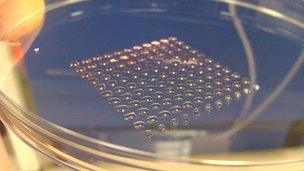Edinburgh scientists use 3D printing to produce stem cells
- Published

The 3D printing technique produces clusters of stem cells
A 3D printing technique that produces clusters of stem cells could speed up progress towards creating artificial organs, Edinburgh scientists have claimed.
In the more immediate future it could be used to generate biopsy-like tissue samples for drug testing.
The technique relies on an adjustable "microvalve" to build up layers of human embryonic stem cells (hESCs).
It has been developed by scientists at Heriot Watt University.
Those involved in the research said it could pave the way for specially created organs, which might eliminate the need for organ donation.
3D printing technology has been increasingly used in numerous industries, ranging from creating clothes, architectural models and even chocolate treats.
Scientists have long been experimenting with the 3D printing of cells and blood vessels, building up tissue structure layer by layer with artificial cells.
Dr Will Shu, from Heriot-Watt University in Edinburgh, said: "We found that the valve-based printing is gentle enough to maintain high stem cell viability, accurate enough to produce spheroids of uniform size, and most importantly, the printed hESCs maintained their pluripotency - the ability to differentiate into any other cell type."
Animal-free testing
Embryonic stem cells, which originate from early stage embryos, are blank slates with the potential to become any type of tissue in the body.
In the long term, the new printing technique could pave the way for hESCs being incorporated into transplant-ready laboratory-made organs and tissues, said the researchers.
The 3D structures will also enable scientists to create more accurate human tissue models for drug testing.
Cloning technology can produce embryonic stem cells, or cells with ESC properties, containing a patient's own genetic programming.
Artificial tissue and organs made from the cells could be implanted into the patient from which they are derived without triggering a dangerous immune response.
Jason King, business development manager of stem cell biotech company Roslin Cellab, which took part in the research, said: "Normally laboratory grown cells grow in 2D but some cell types have been printed in 3D.
"However, up to now, human stem cell cultures have been too sensitive to manipulate in this way.
"This is a scientific development which we hope and believe will have immensely valuable long-term implications for reliable, animal-free, drug testing, and, in the longer term, to provide organs for transplant on demand, without the need for donation and without the problems of immune suppression and potential organ rejection."
The research is published in the journal Biofabrication.
- Published21 January 2013
- Published16 September 2011
- Published21 March 2012